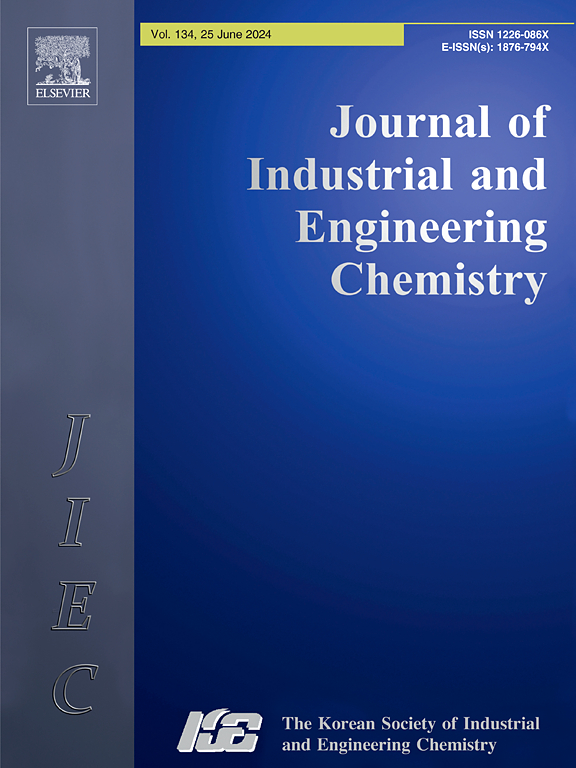High-performance electrochemical detection of furazolidone: Investigating the synergistic effects of SnO2/MoO3 and carbon black composite
IF 5.9
3区 工程技术
Q1 CHEMISTRY, MULTIDISCIPLINARY
Journal of Industrial and Engineering Chemistry
Pub Date : 2024-12-05
DOI:10.1016/j.jiec.2024.12.003
引用次数: 0
Abstract
Antibiotics are crucial in modern medicine for combating bacterial illnesses and saving lives. Still, their overuse has led to the rise of antibiotic-resistant bacteria, creating a serious public health risk. This study offers a unique approach for synthesizing a SnO2/MoO3 composite via precipitation and integrating it with commercial carbon black (CB) to make a SnO2/MoO3/CB composite. This substantially increases electrochemical detection, especially for antibiotics like furazolidone (FZD). The study uses multiple spectroscopic techniques to thoroughly characterize the SnO2/MoO3/CB composite, demonstrating its potential as an electrochemical sensor. We used a screen-printed carbon electrode (SPCE) to detect FZD. We found that the composite performed exceptionally well, with a detection limit of 0.01 µM owing to the enhanced surface area of the proposed sensor related to other modified electrodes. The sensor demonstrated good sensitivity (4.125 µA µM−1 cm−2) and selectivity and excellent real-time detection capability FZD in water samples, urine, and pharmaceutical samples. In these real-world samples, the SnO2/MoO3/CB@SPCE sensor also showed outstanding selectivity and recovery rates for FZD. This paper demonstrates a substantial advancement in the development of SnO2/MoO3/CB-SPCE sensors for antibiotic detection, with important implications for healthcare and environmental monitoring.

呋喃唑酮的高性能电化学检测:研究 SnO2/MoO3 和炭黑复合材料的协同效应
抗生素在现代医学中对对抗细菌疾病和挽救生命至关重要。然而,它们的过度使用导致了耐抗生素细菌的增加,造成了严重的公共健康风险。本研究提供了一种独特的方法,通过沉淀法合成SnO2/MoO3复合材料,并将其与商用炭黑(CB)集成,制成SnO2/MoO3/CB复合材料。这大大增加了电化学检测,特别是对抗生素,如呋喃唑酮(FZD)。该研究使用多种光谱技术彻底表征了SnO2/MoO3/CB复合材料,展示了其作为电化学传感器的潜力。我们使用丝网印刷碳电极(SPCE)检测FZD。我们发现这种复合材料表现得非常好,由于与其他修饰电极相关的传感器的表面积增强,其检测限为0.01µM。该传感器具有良好的灵敏度(4.125µAµM−1 cm−2),选择性和出色的实时检测能力(FZD),可用于水样、尿液和药物样品。在这些实际样品中,SnO2/MoO3/CB@SPCE传感器对FZD也表现出出色的选择性和回收率。本文展示了用于抗生素检测的SnO2/MoO3/CB-SPCE传感器的重大进展,对医疗保健和环境监测具有重要意义。
本文章由计算机程序翻译,如有差异,请以英文原文为准。
求助全文
约1分钟内获得全文
求助全文
来源期刊
CiteScore
10.40
自引率
6.60%
发文量
639
审稿时长
29 days
期刊介绍:
Journal of Industrial and Engineering Chemistry is published monthly in English by the Korean Society of Industrial and Engineering Chemistry. JIEC brings together multidisciplinary interests in one journal and is to disseminate information on all aspects of research and development in industrial and engineering chemistry. Contributions in the form of research articles, short communications, notes and reviews are considered for publication. The editors welcome original contributions that have not been and are not to be published elsewhere. Instruction to authors and a manuscript submissions form are printed at the end of each issue. Bulk reprints of individual articles can be ordered. This publication is partially supported by Korea Research Foundation and the Korean Federation of Science and Technology Societies.

 求助内容:
求助内容: 应助结果提醒方式:
应助结果提醒方式:


